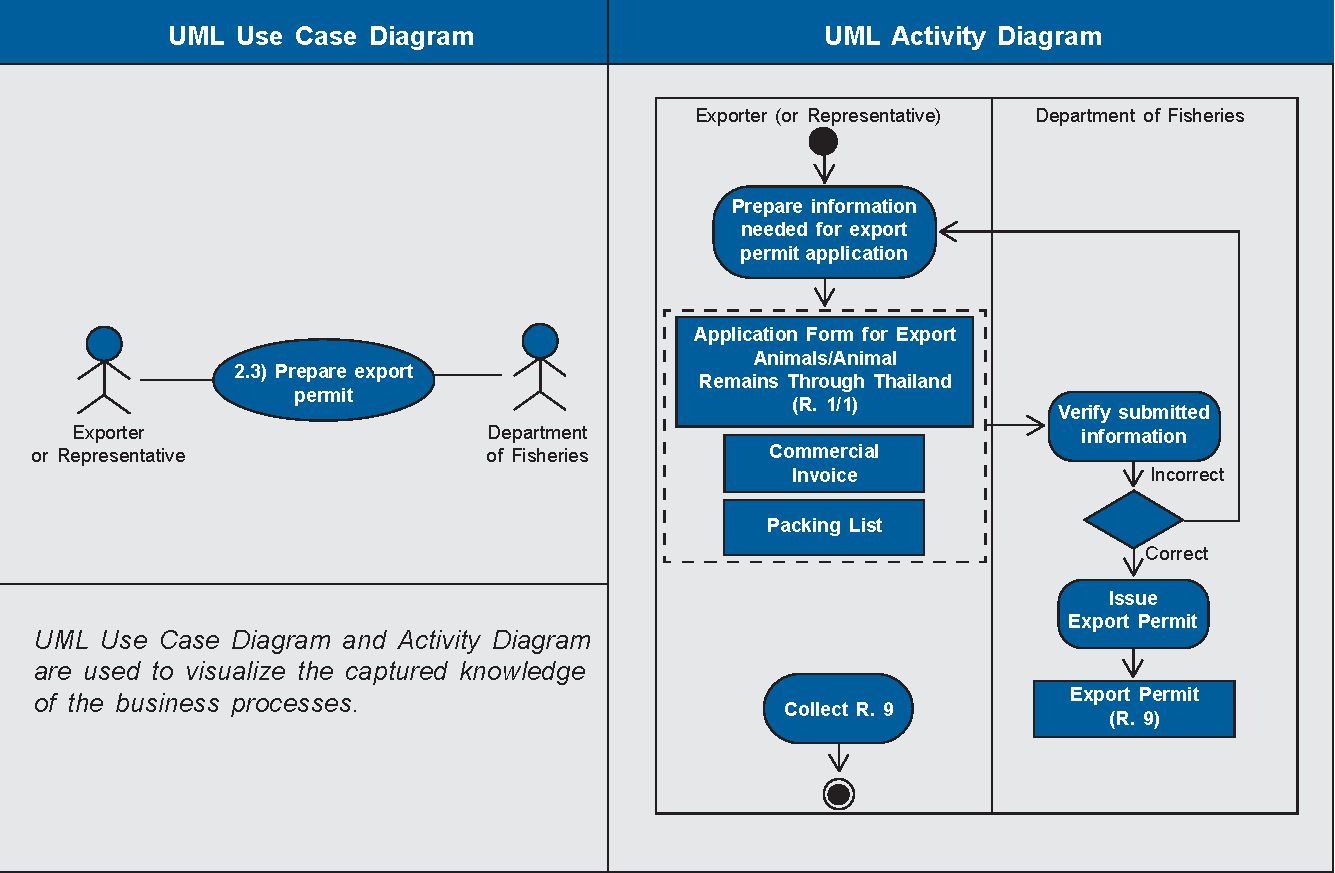Diagrams
Diagrams are used to help visualizing and understanding processes at many different levels. Each of the diagrams provides a simplified view of the overall process, allowing to break down the complexity of the overall process. The most commonly used language for the process modeling is UML. Below is a brief introduction to two UML diagrams that are frequently used.
Use-Case Diagram
Use-Case diagrams are used to show the requirements by the parties involved in the selected process. Acticity diagrams list the high level activities fo the process. The processes and data exchanged in each high level activity is further documented in the Activity diagram.
Use-case diagrams show steps of an overall process. As you can see in the diagram below the transport component of an export transactions is composed of eight use cases. (See Buy-Ship-Pay Model for the overall process model)

Example: Departure of goods from Customs territory
| Name | Departure of goods from Customs territory |
| Actors | Supplier: Consignor, Invoicer, Payee, Seller Agent: Customs Agent, Customs Broker, Declarant, Bank, Credit Agency, PSI Company, Insurer Carrier : Freight forwarder, Consolidator, Transporter Authority: Customs, Other government agencies such as Health, Immigration, Veterinary, Agricultural. Customer: Buyer, Consignee, Invoicee, Orderer |
| Description | The necessary arrangements are made to enable goods – and the means of transport for commercial use – to leave the Customs territory |
| Pre-condition | Goods were subject to an outright Exportation Declaration |
| Post-condition | Goods – and the means of transport for commercial use – have left the Customs territory |
| Scenario 1 | Starts when goods arrive at the Customs office of departure Prior to departure Supplier/Carrier/Agent declares/reports all goods for outward transport to Authority (Customs office outward) by means of a cargo declaration/declaration of departure/notification Authority (Customs) carries out a technical assessment on the format and content of the cargo declaration/declaration of departure/notification Authority (Customs) informs Supplier/Carrier/Agent about accepting or refusing the cargo declaration/declaration of departure/notification Authority (Customs) records the cargo declaration/declaration of departure/notification Authority (Customs) informs Authority (OGA) Authority (OGA) performs risk assessment Authority (Customs) compares cargo declaration/declaration of departure/notification with goods export information Authority (OGA) informs Authority (Customs) Authority (Customs) carries out risk assessment Authority (Customs) coordinates container/goods/documents check Authority (Customs) informs Supplier/Carrier/Agent Supplier/Carrier/Agent points out the container/goods Authority (Customs) executes container/goods/document check Authority, Authorized Person or other Person seals the consignment .(The loader/shipper/consignor/consolidator/etc may have the responsibility to seal the consignment to the relevant standards, and details noted on the Customs documentation). Authority (Customs) informs Authority (OGA) about the results of the container/goods/documents check Authority (Customs) releases the container/goods (and the means of transport) for departure Authority (Customs) informs Authority (Customs office of transit /Customs office inward/Customs office inland) Authority (Customs) informs Supplier/Carrier/Agent Supplier/Carrier/Agent accepts the release information Ends when goods (and the means of transport for commercial use) leave the Customs territory |
Activity diagram
An activity diagram reflects the behavioural aspects of the process model. It shows the flow of activities, specified by actors and includes information on the objects , such as data or documents transmitted or produced. The actors are shownin terms of “swim lanes”. Usually an activity diagram and a use-case diagram complement each other with the activity diagram providing more detail on the activities occurring in a particular use case. (see illustration at the top of the page).
The Customs example shows the activities involving the Supplier (or his Agent), the Transporter and various Customs and other Authorities in the inspection and clearance of goods for departure from a country (Source: Buy-Ship-Pay Model).
